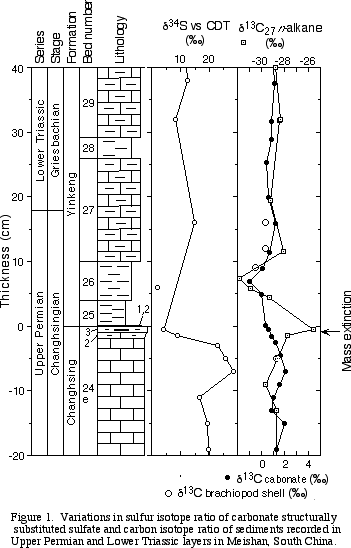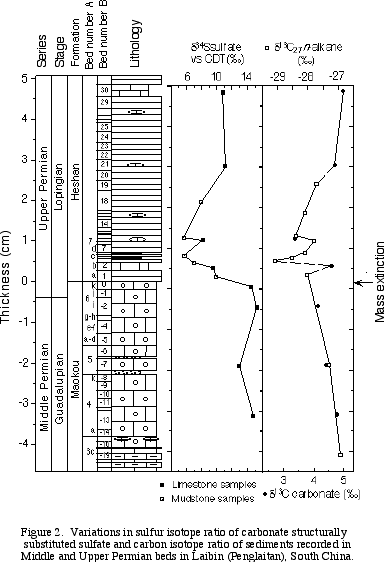Kunio Kaiho1, Yoshimichi Kajiwara2, Takanori Nakano2, Zhongqiang Chen1, Yasunori Miura3, Hodaka Kawahata4, Kazue Tazaki5, Masato Ueshima5, Tomoyuki Ohashi1, Tatsuro Mochinaga1, and Tetsuya Arinobu6
1 Institute of Geology and Paleontology, Tohoku University, Sendai
980-8578, Japan
kaiho@dges.tohoku.ac.jp,
zqchen@dges.tohoku.ac.jp
2 Institute of Geoscience, University of
Tsukuba, Ibaraki 305, Japan yoshikaj@mvi.biglobe.ne.jp,
nakanot@arsia.geo.tsukuba.ac.jp
3 Department of Earth Sciences,
Faculty of Science, Yamaguchi University, Yamaguchi 753-8512,
Japan
dfb30@yamaguchi-u.ac.jp
4 National Institute of Advanced
Industrial Science and Technology (AIST), Tsukuba 305-8567 Japan
h.kawahata@aist.go.jp
5 Department of Earth Sciences, Kanazawa
University, Kanazawa 920-1192, Japan
kazuet@kenroku.kanazawa-u.ac.jp
6 Department of Legal Medicine,
Aichi Medical University School of Medicine, Aichi 480-1195, Japan
arinobu@aichi-med-u.ac.jp
Representing the most profound crisis in the history of earth’s biota, the end-Permian mass extinction triggered the most widespread reorganization of ecosystems and animal diversity in the past 500 million years and is largely responsible for much of the structure of marine ecosystems today (Bowring et al., 1999). However, such severe losses to Paleozoic biota may in fact have resulted from two extinctions during the Late Permian (Stanley and Yang, 1994; Jin et al., 1994). Compared with multidisciplinary evidence documenting the end-Permian crisis (e.g., Erwin, 1993; Bowring et al., 1998; Jin et al., 2000; Becker et al., 2001; Kaiho et al., 2001), another mass mortality at the end-Guadalupian, 8 million years earlier than the end-Permian event (Stanley and Yang, 1994; Jin et al., 1994), has received far less attention. The end-Guadalupian crisis (50 % extinction in marine genus) (Sepkoski, 1994) appears comparable in magnitude with the end-Frasnian (57 %), end-Triassic (53 %), and end-Cretaceous (47 %) mass extinctions, although it is weaker than the end-Permian mass extinction (82%) (see Erwin, 1998 and references there). The duration between these two extinctions is very short (8 million years) compared with durations between the big five mass extinctions (41 to 145 million years). Possible causes of the two events have been thought to be Siberian flood basalt volcanism or an impact of a comet or asteroid for the end-Permian mass extinction and Emeishan flood basalt volcanism for the end-Guadalupian mass extinction.
 |
Our studies in Mieshan, South China and Balvany, Hungary have revealed a remarkable negative shift in sulfate sulfur isotope values at the end of the Permian coinciding with the abrupt mass extinction and concentration of kaolinite, followed by a negative anomaly of d13C values (Fig. 1). These data suggest that an asteroid or a comet hit the ocean at the end of the Permian and caused a rapid and massive release of sulfur from the mantle to the ocean-atmosphere system, leading to significant oxygen consumption, acid rain, and the most severe biotic crisis. Subsequently, a release of CO2 occurred during the 104 to 105 years after the event due to (1) massive denudation of soil and sediments caused by the collapse of forests and (2) decomposition of methane hydrate at the end of the Permian. |
 |
Here we also show a negative shift of sulfate sulfur isotope
values as evidence of a massive release of sulfur coinciding with the
abrupt mass extinction at the end-Guadalupian followed by a negative
excursion of d13C values in Laibin,
South China (Fig. 2). These phenomena are very similar to those at the
end-Permian crisis.
Both events can be explained by impact of an asteroid or comet into the thin oceanic crust, resulting in abrupt gigantic releases of sulfur from the mantle, which contains abundant isotopically light sulfur. However, the negative shift of sulfate sulfur can not be explained by volcanism. The two big impacts into the ocean at the ends of the Guadalupian and Permian may have caused the most severe biotic crisis in the history of life on Earth. |
References
Becker, L., Poreda, R.J., Hunt, A.G., Bunch, T.E. and Rampino, M. 2001. Impact event at the Permian-Triassic boundary: Evidence from extraterrestrial noble gases in fullerenes. Science, 291, 1530-1533.
Bowring, S.A., Erwin, D.H. and Isozaki, Y. 1999. The tempo of mass extinction and recovery: The end-Permian example. Proceedings of the National Academy of Sciences of the United States of America, 96, 8827-8828.
Bowring, S.A., Erwin, D.H., Jin, Y.G., Martin, M.W., David, E.K. and Wang, W. 1998. U/Pb zircon geochronology and tempo of the end-Permian mass extinction. Science, 280, 1039-1045.
Claypool, G.E., Holser, W.T., Kaplan, I.R., Sakai, H. and Zak, I. 1980. The age curves of sulfur and oxygen isotopes in marine sulfate and their mutual interpretation. Chemical Geology, 28, 199-260.
Erwin, D.H. 1993. The great Paleozoic crisis. New York, Columbia University Press.
Erwin, D.H. 1998. The end and the beginning: recoveries from mass extinctions. Trends in Ecology and Evolution, 13, 344-349.
Jin, Y.G., Wang, Y., Wang, W., Shang, Q.H., Cao, C.Q. and Erwin, D.H. 2000. Pattern of marine mass extinction near the Permian-Triassic boundary in south China. Science, 289, 432-436.
Jin, Y.G., Zhang, J. and Shang, Q.H. 1994. Two phases of the end-Permian mass extinction. Canadian Society of Petroleum Geologists, Memoir 17, 813-822.
Kaiho, K., Kajiwara, Y., Nakano, T., Miura, Y., Kawahata, H., Tazaki, K., Ueshima, M., Chen, Z. and Shi, G.R. 2001. End-Permian catastrophe by a bolide impact: Evidence of a gigantic release of sulfur from the mantle. Geology, 29, 815-818.
Sepkoski, J.J. 1994. Extinction and the fossil record. Geotimes, 39, 15-17.
Stanley, S.M. and Yang, X.N. 1994. A double mass extinction at the end of the Paleozoic Era. Science, 266, 1340-1344.